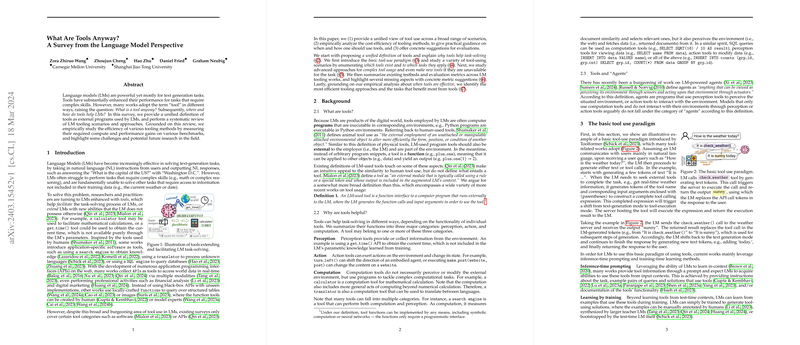A Comprehensive Survey on Tool-Enriched LLMs
Introduction to Tool-Enriched LLMs
LLMs (LMs) have achieved considerable success in generating coherent and contextually relevant natural language responses. However, their capability in handling complex tasks requiring external knowledge and computational skills remains limited. A novel approach to enhance LMs' functionality is through the integration of tools—external programs that LMs can interact with to extend their capabilities beyond mere text generation. This survey rigorously examines the landscape of tool-enrichment in LMs, classifying various tools, their applications, and the methods for integrating them with LMs.
Definition and Utility of Tools
What Constitutes a Tool for LMs?
A critical contribution of this survey is the proposal of a unified definition for tools in the context of LMs. According to the survey, tools are defined as function interfaces to external computer programs that LMs can call, passing inputs and receiving outputs. This definition facilitates a broader understanding and categorization of tools, encompassing those that enable LMs to perceive external information, perform computations, and execute actions in the environment.
How Tools Broaden LM Capabilities
Tools empower LMs in several key areas:
- Perception: Tools like APIs can fetch real-time data, augmenting LMs with dynamic and current knowledge.
- Action: Tools enable LMs to interact with and alter their environment, ranging from sending emails to controlling IoT devices.
- Computation: Tools significantly enhance LMs' ability to perform complex calculations and processing tasks, far beyond their inherent capabilities.
Paradigm of Tool Use
Basic Tool Use Framework
The core framework for tool integration involves LMs generating text sequences that include calls to external tools. Upon detection of a tool call, the environment executes the associated function, passing the results back to the LM for incorporation into its output. This process allows LMs to leverage a wide variety of external functionalities seamlessly.
Scenarios Benefiting from Tools
Application-Specific Enhancements
Tools have shown to be particularly beneficial in tasks requiring access to current information, performing specialized computations, and executing actions within specific domains. Examples include integrating weather APIs for real-time data, employing calculators for mathematical tasks, and using SQL executors for database queries.
Limitations and Considerations
Not all tasks benefit equally from tool integration. In domains where LMs already excel, such as certain language understanding and generation tasks, the addition of tools may not significantly enhance performance. Additionally, the complexity and specific requirements of integrating and managing tools can introduce new challenges.
Advanced Tool Usage Methods
Complex Tool Selection and Utilization
As the diversity of available tools grows, effectively selecting and combining multiple tools becomes crucial. Advanced methods involve strategic tool selection based on task requirements and sophisticated multi-step processes to utilize tools in achieving complex objectives.
Tool Creation and On-the-Fly Adaptation
Beyond pre-existing tools, recent approaches explore the dynamic creation and adaptation of tools by LMs themselves. This enables customized tool creation tailored to specific tasks, significantly expanding LMs' problem-solving capabilities.
Evaluation Metrics and Future Directions
Current Evaluation Practices
Evaluations focus on the effectiveness of tool integration, typically measured by performance improvements in specific tasks. However, considerations such as computational efficiency, tool quality, and reliability also warrant attention.
Desiderata for Tool Usage
Future research should address the efficiency of tool integration, establish rigorous standards for tool performance, and explore mechanisms for ensuring the reliability and reproducibility of tool-enhanced LMs. Additionally, developing benchmarks with executable tools and natural use cases will be crucial for advancing the field.
Conclusion
This survey presents a comprehensive examination of tool-enriched LMs, from defining tools and describing their integration to evaluating their impact on LM capabilities. By highlighting current practices, challenges, and future research directions, this survey lays the groundwork for further exploration and innovation in enhancing LMs with external tools, promising significant advancements in artificial intelligence and natural language processing.
